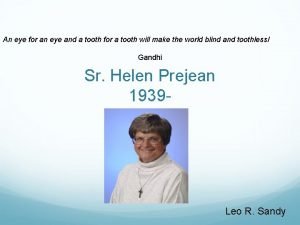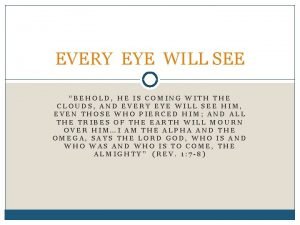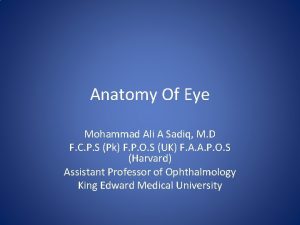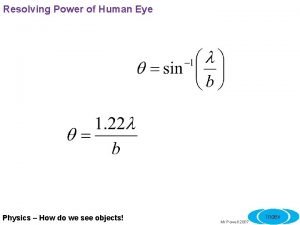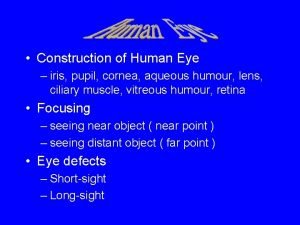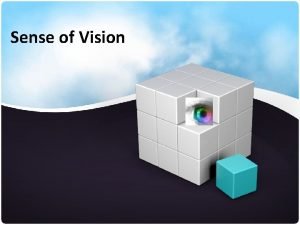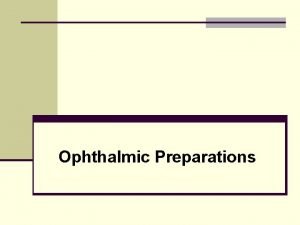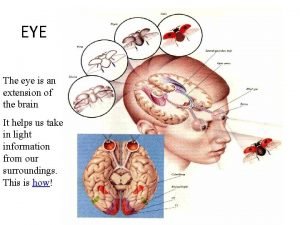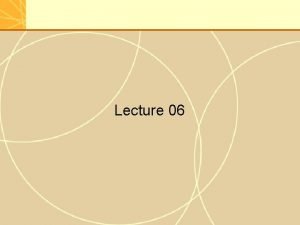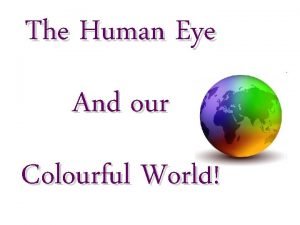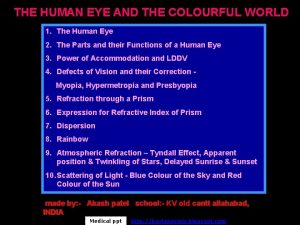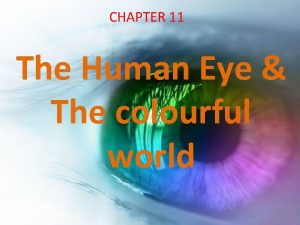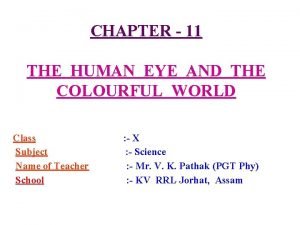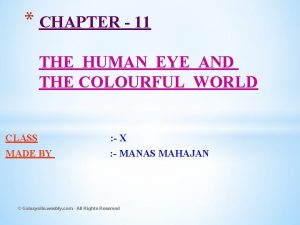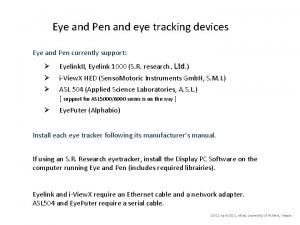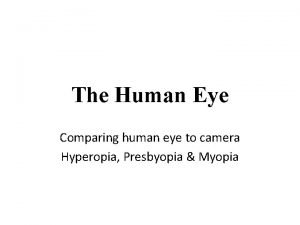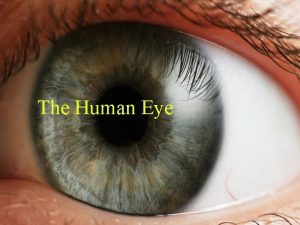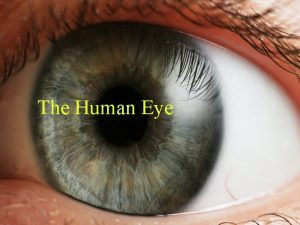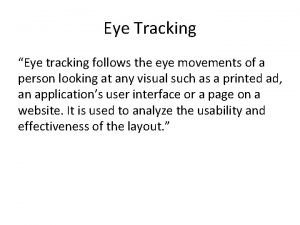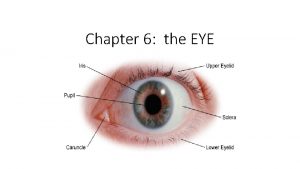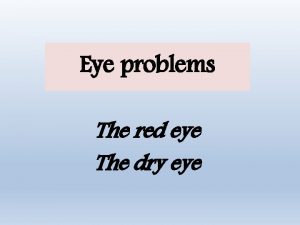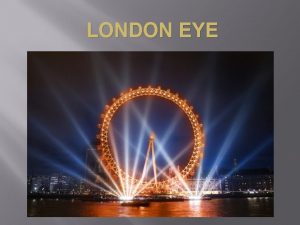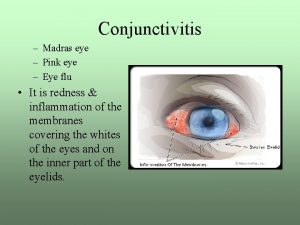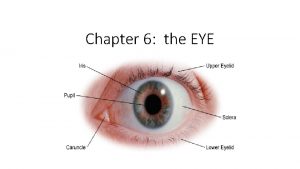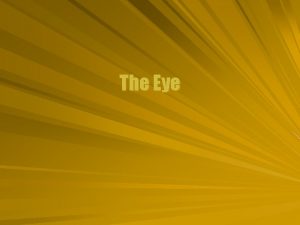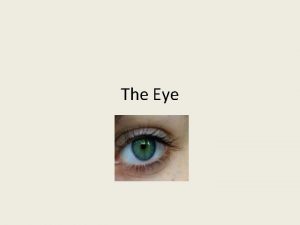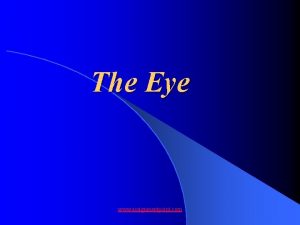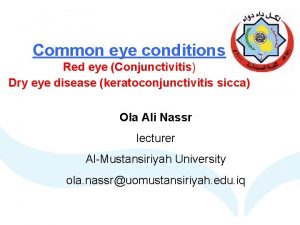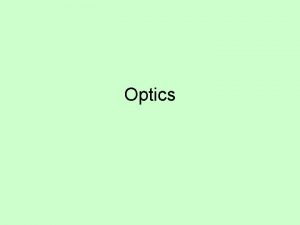THE HUMAN EYE AND THE COLOURFUL WORLD 1




























- Slides: 28

THE HUMAN EYE AND THE COLOURFUL WORLD 1. The Human Eye 2. The Parts and their Functions of a Human Eye 3. Power of Accommodation, LDDV and Far Point 4. Defects of Vision and their Correction Myopia, Hypermetropia and Presbyopia 5. Refraction through a Prism 6. Expression for Refractive Index of Prism 7. Dispersion 8. Rainbow 9. Atmospheric Refraction – Tyndall Effect, Apparent position & Twinkling of Stars, Delayed Sunrise & Sunset 10. Scattering of Light - Blue Colour of the Sky and Red Colour of the Sun Created by C. Mani, Deputy Commissioner, KVS RO Gurgaon

THE HUMAN EYE

Cross Section through a Human Eye Aqueous humour Pupil

Cross Section through a Human Eye

Parts and functions of a Human Eye • The human eye is like a camera. • Its lens forms an image on a light-sensitive screen called the retina. • Light enters the eye through a thin membrane called the cornea. • Cornea forms the transparent bulge on the front surface of the eyeball. • The eyeball is approximately spherical in shape with a diameter of about 2. 3 cm. • Most of the refraction of light rays entering the eye occurs at the outer surface of the cornea. • The crystalline lens merely provides the finer adjustment of focal length required to focus objects at different distances on the retina. • Iris is a dark muscular diaphragm behind the cornea and it controls the size of the pupil. • The pupil regulates and controls the amount of light entering the eye. • The eye lens forms an inverted real image of the object on the retina.

• The eye lens is composed of a fibrous, jelly-like material. • Its curvature can be modified to some extent by the ciliary muscles. • The change in curvature can thus change the focal length of the lens. • The retina is a delicate membrane having enormous number of lightsensitive cells. • The light-sensitive cells get activated upon illumination and generate electric signals. • These signals are sent to brain via optic nerves. • The brain intercepts these signals and finally processes the information for our perception.

Power of Accommodation The ability of the eye lens to adjust its focal length is called accommodation. The eye lens is composed of a fibrous, jelly-like material and its curvature can be modified by the ciliary muscles. Hence, the focal length can be changed as per the requirement. When the muscles are relaxed, the lens becomes thin. The radius of curvature and hence the focal length increases. This enables us to see the distant objects clearly. When we look at the objects closer to they, ciliary muscles contract decreasing the radius of curvature and hence the focal length. This enables us to see the nearby objects clearly. Least Distance of Distinct Vision (LDDV): The minimum distance, at which objects can be seen most distinctly without strain, is called Least Distance of Distinct Vision. For a normal eye, LDDV is 25 cm. Far Point: The farthest point upto which the eye can see objects clearly is called far point of the eye. Far point for a normal eye is infinity. A normal eye can see objects clearly that are between 25 cm and infinity.

DEFECTS OF VISION AND THEIR CORRECTION Myopia or Short-sightedness or Near-sightedness A person with myopic eye can see nearby objects clearly but cannot see distant objects distinctly. A person with this defect has the far point nearer than infinity. Such a person may see clearly upto a distance of a few metres. In myopic eye, the image of a distant object is formed in front of the retina and not on the retinal itself. This defect may arise due to (i) excessive curvature of the eye lens (short focal length of the eye lens) or (ii) Elongation of the eyeball. Myopia can be corrected by using a concave lens of suitable power (focal length).

Myopic Eye O I Near Point LDDV = 25 cm O I LDDV = 25 cm Myopic Eye corrected with Concave Lens I

Hypermetropia or Long-sightedness or Far-sightedness A person with hypermetropia can see distant objects clearly but cannot see nearby objects distinctly. A person with this defect has the near point farther away from the normal near point (25 cm). Such a person may has to keep a reading material much beyond 25 cm from the eye for comfortable reading. In myopic eye, the image of a nearby object is formed behind the retina and not on the retinal itself. This defect may arise due to (i) long focal length of the eye lens or (ii) Very small size of the eyeball. Hypermetropia can be corrected by using a convex lens of suitable power (focal length).

Hypermetropic Eye O I Near Point LDDV = 25 cm O II LDDV = 25 cm Hypermetropic Eye corrected with Convex Lens

Presbyopia The power of accommodation of the eye usually decreases with ageing. For most of the people, near point gradually recedes away. They can not see nearby objects comfortably and distinctly without corrective eye-glasses. This defect is called presbyopia. It arises due to (i) gradual weakening of the ciliary muscles and (ii) diminishing flexibility of the eye lens. Sometimes, a person may suffer from both myopia and hypermetropia. Such people require bi-focal lenses which consists of both concave and convex lenses. The upper portion is concave for distant vision and the lower portion is convex for near vision.

REFRACTION OF LIGHT THROUGH A TRIANGULAR PRISM Activity Pr is A m Refracting Surfaces Eye S P Q i N 1 e R N 2

Refraction of Light through Prism: A A N 1 D Q P N 2 δ e i R r 1 O r 2 μ B S C Prism Refracting Surfaces i+e=A+δ δ sin (A + δm) μ= sin 2 A 2 δm 0 i=e i

DISPERSION OF WHITE LIGHT THROUGH A PRISM The phenomenon of splitting a ray of white light into its constituent colours (wavelengths) is called dispersion and the band of colours from violet to red is called spectrum (VIBGYOR). A D δv N δr R O Y G B White light I V B C Screen Cause of Dispersion: μv = sin i sin rv and μr = sin i sin rr Since μv > μr , rr > rv So, the colours are refracted at different angles and hence get separated.

Dispersion can also be explained on the basis of Cauchy’s equation. b c (where a, b and c are constants for the material) μ=a + 2 + λ λ 4 Since λv < λ r , μv > μr But δ = A (μ – 1) Therefore, δv > δr So, the colours get separated with different angles of deviation. Violet is most deviated and Red is least deviated. Recombination of spectrum of white light: A B’ C’ N White light B C A White light

RAINBOW

Formation of Primary Rainbow Rain drop Sunlight 41º 43º A line parallel to Sun’s ray Eye

A rainbow is a natural spectrum which is caused by dispersion of sunlight by tiny water droplets present in the atmosphere after a rain shower. The incident sunlight with suitable angle of incidence is refracted, dispersed, internally reflected and finally refracted out by the rain drops. Due to the dispersion and internal reflection, different colours reach the eye of the observer. A rainbow is always formed in a direction opposite to that of the Sun. There are primary and secondary rainbows. In the primary rainbow the violet colour is on the inner arc and the red colour is on the outer arc. Secondary Primary In the secondary rainbow, the sequence of colours is opposite due to two internal reflections inside the rain drops.

ATMOSPHERIC REFRACTION Refraction of light by earth’s atmosphere is called atmospheric refraction. Flickering of objects above a fire: The apparent random wavering or flickering of objects can be seen through a turbulent stream of hot air rising above a fire. The air just above the fire becomes hotter than the further up. The hotter air is lighter than the cooler air above it, and has a refractive index slightly less than that of the cooler air. Since the physical conditions of the refracting medium (air) are not stationary, the apparent position of the object, as seen through the hot air, fluctuates. This wavering is therefore due to an effect of atmospheric refraction on a small scale in the local environment.

Twinkling of Stars: The twinkling of a star is due to atmospheric refraction of starlight. Since the atmosphere bends starlight towards the normal, the apparent position of the star is slightly different from its actual position. The star appears slightly higher (above) than its actual position when viewed near the horizon. This apparent position is not stationary, but keeps on changing slightly, since the physical conditions of the earth’s atmosphere are not stationary. Apparent position of the Star Density of Atmosphere & Refractive index increase The atmospheric refraction occurs in a medium of gradually changing refractive index. Real position of the Star Since the stars are very distant, they approximate pointsized sources of light. As the path of rays of light coming from the star goes on varying slightly, the apparent position of the star fluctuates and the amount of light entering the eye flickers- the star sometimes appear brighter, and at some other time, fainter which gives the twinkling effect. Eye

Why Planets do not twinkle? The planets are much closer to the earth, and are thus seen as extended sources. Since it is the collection of large number of point-sized sources of light, the total variation in the amount of light entering into the eye from all the individual sources will average out to zero, thereby nullifying the twinkling effect. Apparent position of the Sun Advance Sunrise and Delayed Sunset: The Sun is visible to us about 2 minutes before the actual sunrise, and about 2 minutes after the actual sunset because of atmospheric refraction. Atmosphere Earth Horizon Real position of the Sun

SCATTERING OF LIGHT BY TINY WATER DROPLETS IN THE MIST

SCATTERING OF LIGHT BY SMOKE & COLLOIDAL PARTICLES

SCATTERING OF LIGHT - Activity Conc. Sulphuric acid L 1 L 2 S Screen I Sodium thio sulphate solution (hypo)

SCATTERING OF LIGHT Tyndall Effect: The earth’s atmosphere is a heterogeneous mixture of minute particles. These particles include smoke, tiny water droplets, suspended particles of dust and molecules of air. When a beam of light strikes such fine particles, the path of the beam becomes visible. The light reaches us, after being reflected diffusedly by these particles. The phenomenon of scattering of light by the colloidal particles gives rise to Tyndall Effect can be seen when a fine beam of sunlight enters a smoke-filled room through a small hole. In this, scattering of light makes the particles visible. It can also be seen when sunlight passes through a canopy of a dense forest. In this, tiny water droplets in the mist scatter light. The colour of the scattered light depends on the size of the scattering particles. Very fine particles scatter mainly blue light while particles of larger size scatter light of longer wavelengths. If the size of the scattering particles is large enough, then, the scattered light may even appear white.

Scattering of Light – Blue colour of the sky and Reddish appearance of the Sun at Sun-rise and Sun-set: Less Blue colour is scattered Horizon Earth Atmosphere Other colours mostly scattered

The molecules of the atmosphere and other particles that are smaller than the longest wavelength of visible light are more effective in scattering light of shorter wavelengths than light of longer wavelengths. The amount of scattering is inversely proportional to the fourth power of the wavelength. (Rayleigh Effect) Light from the Sun near the horizon passes through a greater distance in the Earth’s atmosphere than does the light received when the Sun is overhead. The correspondingly greater scattering of short wavelengths accounts for the reddish appearance of the Sun at rising and at setting. When looking at the sky in a direction away from the Sun, we receive scattered sunlight in which short wavelengths predominate giving the sky its characteristic bluish colour. More in Higher Class…
 Colourful sentence for class 1
Colourful sentence for class 1 Adjectives colourful semantics
Adjectives colourful semantics Skinny comparative
Skinny comparative Colourful semantics template
Colourful semantics template Worms eye view camera angle
Worms eye view camera angle An eye for an eye hammurabi
An eye for an eye hammurabi An eye for an eye hammurabi
An eye for an eye hammurabi Normal eye vs anemic eye
Normal eye vs anemic eye Hammurabi's code activity
Hammurabi's code activity An eye for an eye a tooth for a tooth sister act
An eye for an eye a tooth for a tooth sister act Explain
Explain An eye for an eye meaning
An eye for an eye meaning Behold he is coming
Behold he is coming Pars plicata
Pars plicata Aperture in human eye
Aperture in human eye Resolving power of human eye
Resolving power of human eye Construction of pupil
Construction of pupil Introduction of human eye
Introduction of human eye Introduction of human eye
Introduction of human eye Eye structure and function
Eye structure and function Chapter 8 human needs and human development
Chapter 8 human needs and human development Chapter 8 human needs and human development
Chapter 8 human needs and human development Non human nouns
Non human nouns Ap world history chapter 25 africa and the atlantic world
Ap world history chapter 25 africa and the atlantic world The changing world output and world trade picture
The changing world output and world trade picture The changing world output and world trade picture
The changing world output and world trade picture Hình ảnh bộ gõ cơ thể búng tay
Hình ảnh bộ gõ cơ thể búng tay Ng-html
Ng-html Bổ thể
Bổ thể









